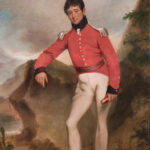William Light was born on 27th April 1786 at Kuala Kedah in Malaya, the son of Captain Francis Light and Martinha Rozells. His mother was not married to Francis Light, who was himself illegitimate and something of an Imperial adventurer.
At the age of six William Light was sent to England for his education and stayed with family friends at Theberton, Suffolk. In 1799 he enlisted in the Navy and was a midshipman by the time he left the service two years later. The completion of his education with a Grand Tour on the Continent was interrupted by the renewal of war between England and France and after a short period in India he returned to England, purchasing a commission in the 4th Dragoons in 1808 and serving with distinction in the Peninsular War. In 1821 he sold his commission and on 24th May married a Miss E. Perois, about whom little is known. Light then served in the Spanish army where he reached the rank of lieutenant-colonel.
He remarried on 16th October 1824, his wife being Mary Bennet, the illegitimate daughter of the third Duke of Richmond. Light and his new, wealthy wife resumed the Grand Tour, enabling the colonel to hone his undoubted artistic skills. In Egypt he had his first contacts with the promoters of a new colony in South Australia. He separated from his wife in 1832 after she had formed a relationship with another officer and Light himself took as a lover the 21-year-old Maria Gandy, whom he brought with him to South Australia in 1836.
Colonel Light missed out on the governorship of the new colony, but was appointed Surveyor-General as a consolation. He sailed with a part of his survey party on the Rapid, arriving at Kangaroo Island on 17th August 1836. He had the Herculean task of choosing a site for the capital and surveying sufficient town and country land for the fractious first settlers, who had already embarked for South Australia. Much has been written about Light’s ‘Vision’, about his conflicts with the first Governor, John Hindmarsh, and with his own deputy, George Strickland Kingston, and the degree of innovation in his town plan. But it is clear that had he not remained firm in the face of criticism, jealousy and indecision, the new colony might not have survived its first two years.
His official career, however, was remarkably short. After yet another dispute over the pace of the survey work, he resigned in 1838 and went into private practice as a surveyor. His health had already begun to deteriorate, his temporary accommodation was burnt down with the loss of most of his papers and art work, and he moved to a new house which he named ‘Theberton’. There he was nursed by Maria Gandy but died of tuberculosis on 6th October 1839, rich in assets because of the size of his landholdings but poor in income. The factionalism of the early colonists pursued him to his death. A number of them avoided him because of old grudges, and some, including the Colonial Chaplain, refused to visit him, even on his deathbed, because he was living with his mistress.
Ironically, it was Light’s death which briefly set aside previous enmities. Governor George Gawler was anxious to show an appropriate level of respect and this resulted in what was, in essence, South Australia’s first State funeral. It was the largest assembly of people yet congregated within the colony. The self-styled ‘Founder of Adelaide’ was carried to his vault in Light Square in Adelaide’s first hearse, a two-wheeled jinker recently imported from Tasmania and pulled by the settlement’s first black horse. A substantial Gothic Revival sandstone monument, built to a design by Kingston and paid for by public subscription, was erected over the vault in 1843 but severe deterioration led to its being replaced with a granite memorial in 1905. A statue of Light was erected in Victoria Square in 1906 and was moved to its present location on Montefiore Hill, North Adelaide, in 1938.






Comments